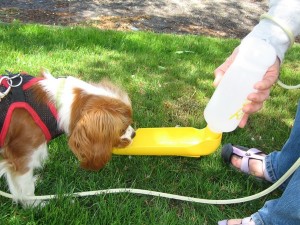Chloe came from a breeder just outside San Diego, so the very first thing we needed to do with our new dog was fly with her from San Diego to Seattle. I went online for instructions, and found a lot of general advice but nothing detailed. Here are the details I wished for then. [Please check out my 4/30/10 guest post on Fido Friendly’s blog about flying with an in-cabin dog for a newer, and slightly more organized, version of this post.]
Before you go
Buy a good airplane carrier. I know they’re expensive, but a good one is worth the extra expense. If you travel a lot, you will be annoyed a lot by cheap materials, bad zippers and bad design in general.
Spend time getting your dog comfortable with her carrier. Leave it open on the floor of the room she ordinarily occupies, and encourage her to go into it to get extra-tasty treats. Lavish praise (and more treats) on her when she does. Toss a favorite toy inside, and praise her warmly when she retrieves it. In small steps, work towards getting her not to fret when you close her inside the carrier; when you pick her up in the carrier; and when you walk around the house with her in the carrier. Use the top hatch of your carrier, if it has one, to rain treats on your dog while she’s inside it. Take her in her carrier to fun places (to the dog park, for example, or to Petco) as well as to the vet and on airplanes, so she has no fixed associations with the carrier.
Some dogs don’t need a huge amount of acclimating — maybe you’ll be lucky enough to find that your dog is one of them. Four month-old Chloe, because of circumstances beyond everyone’s control, saw her carrier for the first time about 30 seconds before she got tucked into it for an all-day set of flights up the West Coast. She never made a peep in her carrier then, and hasn’t since.
Read Dog Jaunt’s travel check list and packing list! It will help you plan, pack and depart in an organized way.
The day of travel
If we have an early-morning flight, I don’t feed Chloe after her evening meal the night before. I usually pack late into the night, so before we go to bed I pick up her water as well. In the morning, we spend a long time in the side yard, making sure she pees and poops before we leave. If you can get a walk in, all the better, but it shouldn’t be so vigorous that she wants to gulp down water when she returns.
If we have a flight later in the day, I feed Chloe breakfast, and pick up her water about four hours before we leave for the airport. She gets a long walk in the morning; just before we leave, we spend a long time in the side yard.
I do not give Chloe a sedative. She’s a good traveler, and doesn’t need it. Although you can find vets and on-line resources on both sides of the argument, I am more convinced by the school of thought that regards sedatives as dangerous for small traveling pets. (Short-nosed dogs like pugs, French bulldogs, English toy spaniels, and Boston terriers absolutely should not have a sedative if they’re traveling as cargo.) Discuss the issue with your vet. Do not even consider dosing your dog yourself with a human sedative!!
Chloe has a SturdiProducts carrier, but the following steps should work for any good-quality carrier. I line the very bottom with an (unscented) weewee pad, then put in the carrier’s sheepskin floor pad. (Either the wee wee pad will catch leaks, or it will serve as a back-up if the DryFur pad on top gets soiled and has to be discarded.) On top of the sheepskin pad, I put a Dry Fur pad, and that’s the surface she’ll rest on during her travels. In with her goes a small comfort blanket or towel, a favorite soft toy and a bully stick. And then in goes Chloe, wearing her collar with ID and rabies tags.
In the end pocket of her carrier I put her harness and leash, a large Ziploc bag (to contain a soiled pad, if the worst happens), a collapsible travel bowl, a packet of treats, a roll of poop bags (for use during layovers), her health certificate and a copy of her shot record. Consider including a photo of your dog.
Remember to bring an empty water bottle with you, to be filled after you clear security.
Chloe rides to the airport in her carrier, because our timing is usually close by this point, and when we arrive at the airport parking lot I don’t want to be cramming her into her carrier while we’re getting bags onto the airport shuttle and stowing keys and car claim ticket. I’d rather get her in at home, in a familiar environment.
At the airport
At the airport, Chloe’s carrier rests by my feet while we pay for her and for extra bags (there’s always at least one, because she has a bag of her own to check). Only one ticket agent has ever asked to see her carrier; to date, no one has ever asked to see her health certificate (though she always has one — I don’t cut that particular corner). Consider asking for a middle seat, since they usually have the most under-seat room. [Update: Dozens of flights later, I know that the middle seat sometimes isn’t the best choice. Check out Dog Jaunt’s series of posts about which seats work best for an in-cabin dog.]
Recall that your dog in her carrier takes the place of your carry-on bag, so a solo traveler can only carry a dog and a “small personal item” — for me, a substantial but not heinous purse.
So now we’re down to my husband’s carry-on bag and small personal item, and my purse and Chloe in her carrier. It’s time to go through security. I recommend getting your computer into a bin, and your shoes and 3-1-1 bag and jacket into another, before you deal with your dog. Place your carrier on the belt behind your bins, unzip the opening, reach in and clip a leash on your dog’s collar and scoop her out into your arms. By now she may be reluctant to leave the carrier, so someone may have to hold it in place while you scoop. The leash is important, because you just don’t know how wigged out your dog might be at the airport, or if a sudden event in the security line might send her scrambling for “safety” and out of your arms.
The carrier will go on through the x-ray machine. You’ll walk through the metal detector holding your dog in your arms. In all likelihood, the alarm will go off (collar and leash, after all). Consider asking to be wanded, rather than taking off her collar and leash — the latter is faster, but you’ll have a whole new set of problems if your completely naked, wigged-out dog leaps out of your arms and takes off down the concourse. (TSA has no problem with the wanding option, so don’t be shy about asking. In fact, the TSA folks generally melt into a pile of goo when they see Chloe.)
After you get the all clear, put your dog back into her carrier right away, unclipping her leash only after she’s fully inside. At this point, the carrier will be her safe place, so she’ll shoot right back in. Then collect computer, shoes, jacket, etc.
Fill your water bottle at a water fountain.
There’s nothing special about waiting at the gate and boarding the plane with a dog, except that if the gate area is crowded, be thoughtful and put your dog’s carrier on the floor under your feet, not on the seat next to you.
On the plane
The next time your usual routine will change is when you take your seat on the plane. Keep in mind that your dog’s carrier will completely occupy the under-seat area, and take your book, bottle of water, neck pillow, etc. out of your small personal item and toss them onto your seat. Put your gutted SPI into the overhead compartment and push your dog’s carrier fully under the seat in front of you.
During the flight, and especially if you have understanding seat mates (deploy your adorable dog photo while you’re taxiing and climbing out), you can move your dog’s carrier out a bit and under your feet, or even onto your lap, but you cannot take your dog out of her carrier. At most, I will unzip the carrier just enough to stick my arm in to rest against Chloe. She’s snoozing, but I think she appreciates the gesture.
During the course of the flight, I will drop several of her favorite treats into her carrier, and I will give her ice cubes in her collapsible bowl or in the palm of my hand. I want her to have enough water not to be dehydrated, but not so much that she has to pee. (The bottle of water is in case she seems thirsty between beverage services. Also, I’ve used a bottle of water to wash salt off Chloe’s paws during one winter layover in Denver.)
If you have a layover
If at all possible, take a direct flight. If you just can’t, schedule a substantial layover — at least an hour, and preferably an hour and a half or more — so that you and your dog can exit the airport, find a pet relief area, and re-enter through security to find your departure gate.
Remember to empty your water bottle before re-entering! I can’t tell you how vexing it is to be on a tight schedule with a dog, and see your SPI being taken off the belt for a hand check. You know right away what they’re checking for, and it means going back out to the terminal, dumping out your water bottle, getting back in the security line….
Re-fill your water bottle once you’ve cleared security.
When you arrive at your destination
If you are traveling with a companion, one of you can collect your bags and the other can take your dog out for a well-deserved comfort stop and a good drink of water. If I’m traveling by myself, I consider the distance to that airport’s pet relief area (or the closest patch of grass) and assess how pressing Chloe’s need is. It is more convenient to give her a quick walk before collecting my luggage, but sometimes that’s just not practical.






